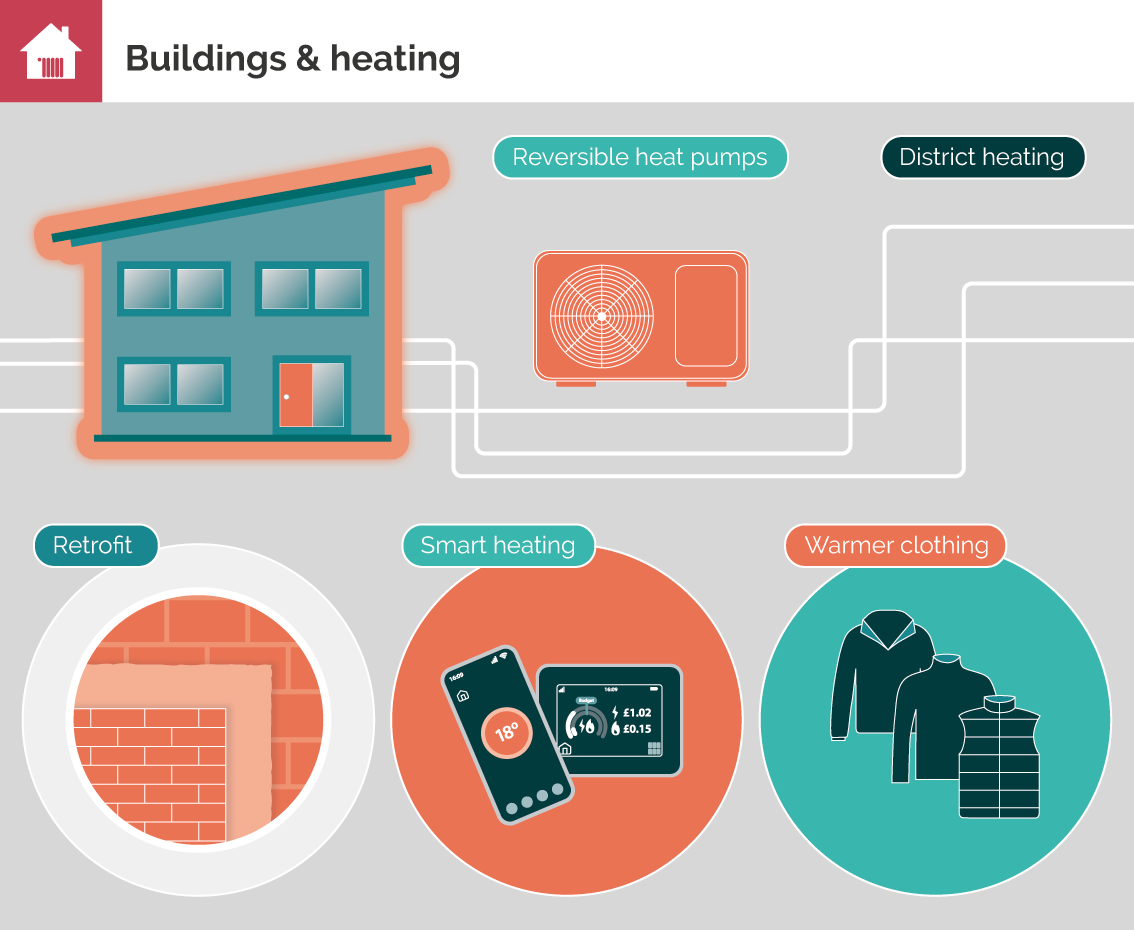
There is a significant resource of untapped energy-saving opportunities in UK homes. Our estimates suggest a technical potential exceeding 50% and a cost-effective potential exceeding 25% by 2035. The majority of the long-term potential comes from moving to high-efficiency heating systems, rather than from insulation [1, 2].
By 2050, heat in buildings will need to be decarbonised. The three major potential routes are hydrogen, individual heat pumps and district heat. All are technically possible, although ‘high hydrogen’ systems raise specific problems, due to their lower cost-effectiveness and the higher value of hydrogen in other applications [3]. Consumer acceptability and supply chain constraints may be key determinants of the overall technology mix [4].
Heating practices are diverse and individually hard to predict. Data from smart heating trials reveals tradeoffs between comfort and cost; diverging preferences for the level, duration and area of heating; conflicts between different users; and the importance of considerations other than thermal comfort [5].
There are important non-technical uncertainties in understanding future heating demand. The thermal performance of clothing could make a significant contribution to energy demand reduction but is an overlooked issue in sustainable fashion [6]. Reversible heat pumps, which are relatively easy to retrofit, can cool as well as heat, which may be important as climate change is likely both to reduce heat load and to increase cooling load by about 20% by 2050 [7]. Energy service-based business models have a long and largely unsuccessful history [8]. Despite this, heat as a service has the potential to play a role in the decarbonisation of heat [9].
Both modelling and observation are needed to understand and manage the challenges of decarbonising heat. Getting heat pumps to work as efficiently as possible is one of the greatest opportunities and challenges to UK decarbonisation and this requires an empirical socio-technical approach [10]. Improving their efficiency, particularly during cold weather, could save as much energy as insulating all UK solid walls [3]. Heat pumps supplied by low-carbon electricity therefore challenge the ‘fabric first’ discourse. Renewable electricity costs are set to continue falling [11] and heat pumps require only a quarter of the energy of boilers, which changes the relative cost-effectiveness of insulation and heating systems in decarbonisation.
The imperative to decarbonise buildings challenges the idea of ‘fabric first’ through deep retrofit. In many buildings, decarbonisation can be achieved by changing to a zero-carbon fuel, in most cases a heat pump using decarbonised electricity. In some cases, this will be the least cost approach to decarbonisation. Insulation should be prioritised where it is relatively cheap (e.g. during refurbishment), essential for health and comfort, and/or needed to ensure efficient operation of heat pumps [12].
On the pathway to full decarbonisation, hybrid appliances which combine a gas boiler with a heat pump, could be a low-cost transitional option, reducing energy demand by 60% compared to gas boilers, and reducing national peak electrical demand by 10 GW compared to air source heat pumps. Control and sizing of the hybrid are critical to its impact [13].
Understanding the dynamics between supply chains, new technologies and the innovation process will be crucial in the context of retrofit [14]. Successful retrofit and renovation for energy efficiency requires attention to be paid to timings, bespoke/building-specific requirements, and complementary objectives, i.e. more than just carbon reduction [15, 16].
Evidence
- The remaining potential for energy savings in UK households | Research paper, 2018
- The role of energy demand reduction in achieving net-zero in the UK | CREDS report, 2021
- Building decarbonisation transition pathways | CREDS Policy brief 013, 2020
- Heat decarbonisation modelling approaches in the UK: An energy system architecture perspective | Research paper, 2020
- Humanizing heat as a service: Cost, creature comforts and the diversity of smart heating practices in the United Kingdom | Research paper, 2020
- Rethinking energy services: The concept of ‘meta-service’ and implications for demand reduction and servicizing policy | Research paper, 2018
- Meeting UK heat demands in zero emission renewable energy systems using storage and interconnectors | Research paper, 2021
- The history of heat-as-a-service for promoting domestic demand-side flexibility: lessons from the case of budget warmth | Research paper, 2021
- Chapter 17: Local heat and energy efficiency policy: ambiguity and ambivalence in England and Scotland | Research paper, 2021
- Ecology of heat pump performance: A socio-technical analysis | Research paper, 2019
- Solar, wind and logistic substitution in global energy supply to 2050 – Barriers and implications | Research paper, 2022
- Fabric first: Is it still the right approach? | Research paper, 2023 (Buildings & Cities, accepted)
- Domestic heating with compact combination hybrids (gas boiler and heat pump): A simple English stock model of different heating system scenarios | Research paper, 2022
- Innovation in deep housing retrofit in the United Kingdom: The role of situated creativity in transforming practice | Research paper, 2020
- Deep retrofit approaches: managing risks to minimise the energy performance gap | Research paper, 2019
- Residential retrofit in the climate emergency: the role of metrics | Research paper, 2020
Banner photo credit: Pat Whelen on Unsplash
